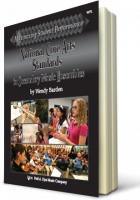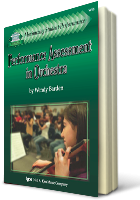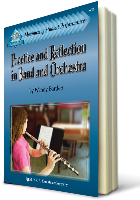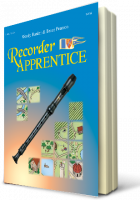A dozen ideas for choice (and voice) in the music room
Many music educators, including me, make very detailed plans for each lesson or rehearsal. What happens when there is an element of choice, giving students responsibility for some of the decisions, too? Choice is one factor that can be very motivating because it gives students power (and voice) in their own learning.
Here are a dozen ideas for bringing choice into your music room, organized by the processes of the National Core Arts Standards. Let these ideas get you thinking of others!
Creating
1. Suppose your students have created an 8-beat rhythm ostinato. What classroom instrument(s) do they think would be best to perform this ostinato with 34. Dance, Dance in the recorder book? Have some students try out their instrument choices as others play the melody, and choose again if they are not happy with the result. Switch roles.
2. Have students create a variation of a favorite line in their lesson book by replacing two notes in each measure with the equivalent rests, then play it. Do they like the sound of their variation? Can they perform the variation without mistakes? If the answer to either question is no, have students make revisions until they are satisfied.
3. Show the class a short commercial (without sound). Students will work with a partner to create a sound track using found sounds (and maybe an instrument or two). What mood or feeling is the commercial communicating to them? What musical choices would students use to convey that feeling?
Performing
4. The learning target is “I can accurately play a B-A-G song on recorder.” What if students could choose one of three B-A-G songs to demonstrate their learning instead of an assigned line? Maybe the pitches in one line have more skips, or there are more eighth notes in another. Maybe one song is a familiar folk song like “Hot Cross Buns” and the others are not. Use one feedback tool to score all of the performances. (If you would like examples of different rubrics and checklists, email wbarden@seguecp.com.)
5. The band is working on 6/8 rhythm lines. Everyone will perform one of the lines at their lesson, choosing to clap it, sizzle it, or perform it using a few pitches. All are scored for rhythmic accuracy, and there is no more credit for using one medium over another.
6. It’s time to select music for the middle level solo festival. What would it take for you to introduce three or four solos to the group, and then have each student select the one they want to learn? Once selected, have students explain why they chose that solo over the others.
7. Next week, visitors are coming to the school and they would like to visit the choir. Involve students to think-pair-share verbally or in writing: What song(s) in the folder would be best to perform for the visitors, and why?
8. Traditionally, the seniors of the orchestra select the featured piece that is performed at graduation. What piece would be best for this occasion, and why? Write short program notes to tell families and the graduation class why this piece fits the occasion.
Responding
9. When students are listening to a recording, have them choose only one element to focus such as timbre, tempo, dynamics, meter, melody, or rhythm. By listening to just one element, students will be better able to describe it in detail and how it changes through the piece (or not). Have students discuss their observations with a neighbor, and then listen again for another element. (If you would like a copy of my Listener’s Pick Two or Listener’s Tic-Tac-Toe, email wbarden@seguecp.com.)
10. The Athletic Director needs your [students’] help selecting a recording of “The Star-Spangled Banner” to play before the wrestling and gymnastic meets. Bring to class three different performances of “The Star-Spangled Banner.” Have students listen to all three and decide which performance would be most appropriate to start these athletic events, and why?
11. In small groups, have students plan a short podcast to celebrate Music In Our Schools Month. The podcast will be posted on the district website. Students are instructed to find three pieces that connect in some way to the theme, and write 2-3 sentences to introduce each piece to listeners.
12. With a partner, have students select two songs/pieces to play in the halls before school or in the cafeteria during lunch. Next step? Write a note to convince the Dean of Students these are perfect choices!
Yes, and… Choice and voice have a way of deepening thinking by Connecting students and the music they are studying. Students connect their interests, skills, and prior knowledge to make choices in music. And, music is more relevant when it connects back to other areas of their lives.
Thanks for pausing with me for a few minutes in your busy week. Have a good one!
____________________
Barden, Wendy. National Core Arts Standards in General Music. San Diego: Kjos Music Press (2015).
Barden, Wendy. National Core Arts Standards in Secondary Music Ensembles. San Diego: Kjos Music Press (2014).
Barden, Wendy and Pearson, Bruce. Recorder Apprentice. San Diego: Neil A. Kjos Music Company (2013).

















